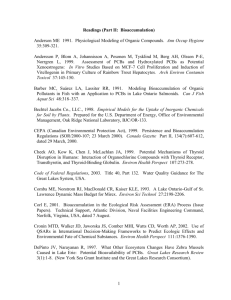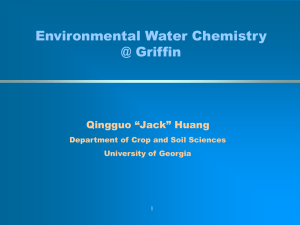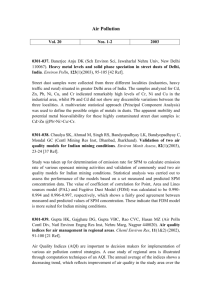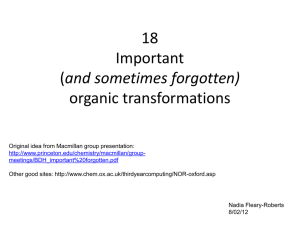etc2283-sm-0001-SuppApp-A
advertisement
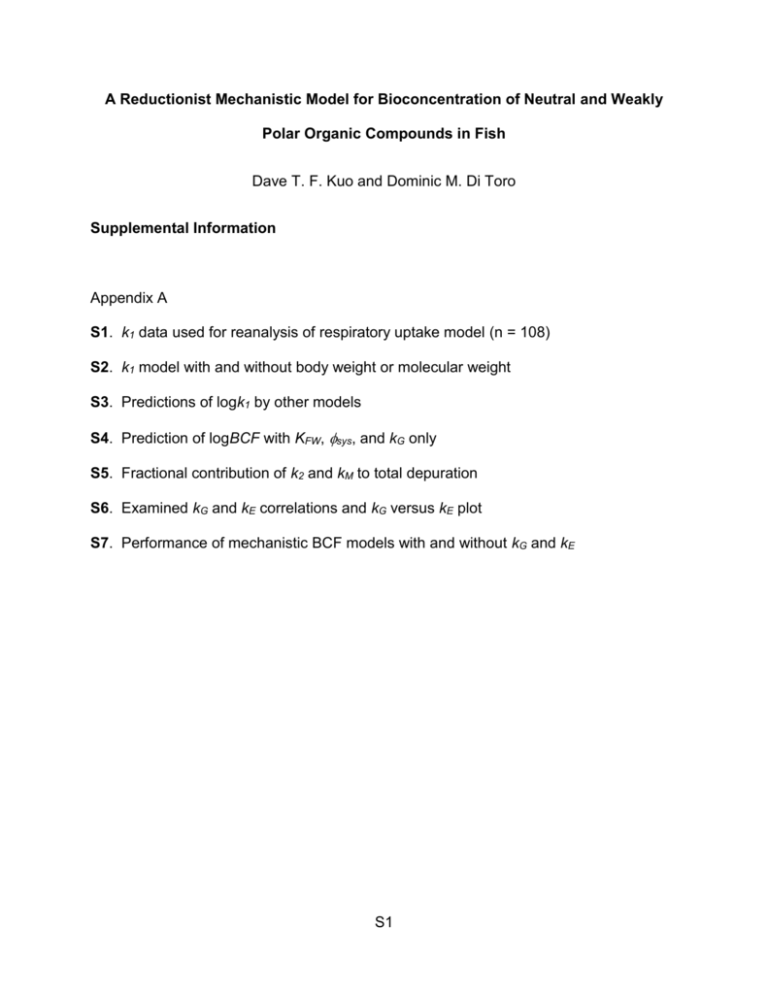
A Reductionist Mechanistic Model for Bioconcentration of Neutral and Weakly
Polar Organic Compounds in Fish
Dave T. F. Kuo and Dominic M. Di Toro
Supplemental Information
Appendix A
S1. k1 data used for reanalysis of respiratory uptake model (n = 108)
S2. k1 model with and without body weight or molecular weight
S3. Predictions of logk1 by other models
S4. Prediction of logBCF with KFW, sys, and kG only
S5. Fractional contribution of k2 and kM to total depuration
S6. Examined kG and kE correlations and kG versus kE plot
S7. Performance of mechanistic BCF models with and without kG and kE
S1
S1. k1 data used for reanalysis of respiratory uptake model (n = 108)
4
3.5
3
logk1
2.5
2
1.5
3
1
3
0.5
0
0
2
4
6
8
10
logKOW
Since the majority of logk1 in the range of logKOW = 3 to 7 are located between ~ 2 and
3.5, the circled points, where logk1’s were less than 1.5.
4
3.5
3
logk1
2.5
2
1.5
1
0.5
0
0.01
0.1
1
10
Body weight W (g)
S2
100
1000
The following k1 data are tabulated for the convenience of the reader and in the case when the report by Brooke and
Crookes has become unavailable. The compilation was largely the effort of Dr. Jon Arnot and partly from the EURAS
database. Please acknowledge their effort when using the following data:
CAS No.
Chemical
Species
logKOW
(L/kg)
k1
(L/kg.d)
W
(gw.w.)
Mol.Wt
(g/mol)
Cox
(mgO2/L)
flipid
(glipid/gw.w.)
T
(oC)
120-82-1
118-74-1
615-54-3
634-90-2
87-61-6
106-37-6
106-46-7
2027-17-0
2027-17-0
575-41-7
91-57-6
91-57-6
575-41-7
85-01-8
91-20-3
91-20-3
3674-75-7
85-01-8
883-20-5
883-20-5
3674-75-7
129-00-0
129-00-0
120-12-7
69806-40-2
50-32-8
1582-09-8
1,2,4-trichlorobenzene
hexachlorobenzene
1,2,4-tribromobenzene
1,2,3,5-tetrachlorobenzene
1,2,3-trichlorobenzene
1,4-dibromobenzene
1,4-dichlorobenzene
2-isopropylnaphthalene
2-isopropylnaphthalene
1,3-dimethylnaphthalene
2-methylnaphthalene
2-methylnaphthalene
1,3-dimethylnaphthalene
phenanthrene
naphthalene
naphthalene
9-ethylphenanthrene
phenanthrene
9-methylphenanthrene
9-methylphenanthrene
9-ethylphenanthrene
pyrene
pyrene
Anthracene
Haloxyfop-methyl
Benzo[a]pyrene
Benzenamine, 2,6-dinitro- N,N-dipropyl-4(trifluoromethyl)Benzenamine, 2,6-dinitro- N,N-dipropyl-4(trifluoromethyl)1,3,5-Triazine, hexahydro-1,3,5-trinitro-(RDX)
2,3,7,8- Tetrachlorodibenzo[b,e] [1,4]dioxin
2,3,7,8- Tetrachlorodibenzo[b,e] [1,4]dioxin
2,3,7,8- Tetrachlorodibenzo[b,e] [1,4]dioxin
2,3,7,8- Tetrachlorodibenzo[b,e] [1,4]dioxin
2,3,7,8- Tetrachlorodibenzo[b,e] [1,4]dioxin
(a)
(b)
(b)
(b)
(b)
(b)
(b)
(c)
(c)
(c)
(c)
(c)
(c)
(c)
(c)
(c)
(c)
(c)
(c)
(c)
(c)
(c)
(c)
(d)
(d)
(d)
(e)
4.02
5.73
4.66
4.56
4.05
3.79
3.44
4.63
4.63
4.42
3.86
3.86
4.42
4.46
3.3
3.3
5.38
4.46
4.89
4.89
5.38
4.88
4.88
4.45
4.05
6.13
5.34
492
1850
1040
631
470
272
112
4188
3746
2909
2659
2142
1854
1783
1450
1137
731
680
623
290
263
129
116
900
720
416
3480
0.48
0.19
0.19
0.19
0.19
0.19
0.19
2.47
2.47
2.47
2.47
2.47
2.47
2.47
2.47
2.47
2.47
2.47
2.47
2.47
2.47
2.47
2.47
0.5
0.6
0.5
6.2
181.45
284.78
314.8
215.89
181.45
235.91
147
170.26
170.26
156.23
142.2
142.2
156.23
178.24
128.18
128.18
206.29
178.24
192.26
192.26
206.29
202.26
202.26
178.24
375.73
252.32
335.29
8
8
8
8
8
8
8
8
8
8
8
8
8
8
8
8
8
8
8
8
8
8
8
7.4
8.6
7.4
7.5
0.05
0.031
0.031
0.031
0.031
0.031
0.031
0.097
0.097
0.097
0.097
0.097
0.097
0.097
0.097
0.097
0.097
0.097
0.097
0.097
0.097
0.097
0.097
0.048
0.048
0.048
0.04
21
23.1
23.1
23.1
23.1
23.1
23.1
25
25
25
25
25
25
25
25
25
25
25
25
25
25
25
25
23.5
17
23.5
23
(1)
(2)
(2)
(2)
(2)
(2)
(2)
(3)
(3)
(3)
(3)
(3)
(3)
(3)
(3)
(3)
(3)
(3)
(3)
(3)
(3)
(3)
(3)
(4)
(5)
(4)
(6)
(e)
5.34
3480
6.89
335.29
8.8
0.07
15
(6)
(e)
(f)
(f)
(f)
(g)
(g)
0.87
6.8
6.8
6.8
6.8
6.8
30.7
765
736
712
1870
1280
0.084
15
15
15
1
1
222.12
321.98
321.98
321.98
321.98
321.98
8
7.2
7.2
7.2
7.2
7.2
0.048
0.085
0.055
0.096
0.19
0.19
25
25
25
25
25
25
(7)
(8)
(8)
(8)
(8)
(8)
1582-09-8
121-82-4
1746-01-6
1746-01-6
1746-01-6
1746-01-6
1746-01-6
S3
Ref.
CAS No.
1582-09-8
56-55-3
226-36-8
95-94-3
120-82-1
88-06-2
106-46-7
935-95-5
87-86-5
87-86-5
87-86-5
92-86-4
634-91-3
636-30-6
87-61-6
634-93-5
634-67-3
57117-44-9
35693-99-3
59080-33-0
60851-34-5
57117-31-4
35693-99-3
30746-58-8
40321-76-4
59080-37-4
35693-99-3
16606-02-3
35065-27-1
39227-28-6
35693-99-3
57653-85-7
35065-27-1
626-39-1
19408-74-3
2921-88-2
51207-31-9
Chemical
Benzenamine, 2,6-dinitro- N,N-dipropyl-4(trifluoromethyl)Benzo[a]anthracene
Octaethylene glycol monotridecyl ether
Octaethylene glycol monotridecyl ether
Dibenz(a,h)acridine
C-12-2-LAS
Benzene, 1,2,4,5- tetrachloroBenzene, 1,2,4-trichloro2,4,6-Trichlorophenol
Benzene, 1,4-dichloro2,3,5,6-Tetrachlorophenol
Phenol, pentachloroPhenol, pentachloroPhenol, pentachloro4,4'-dibromobiphenyl
3,4,5-Trichloroaniline
2,4,5-Trichloroaniline
Benzene, 1,2,3-trichloro2,4,6-Trichloroaniline
2,3,4-Trichloroaniline
1,2,3,6,7,8- Hexachlorodibenzofuran
2,2',5,5'-Tetrachloro-1,1'- biphenyl
2,4,6-Tribromobiphenyl
2,3,4,6,7,8- Hexachlorodibenzofuran
2,3,4,7,8- Pentachlorodibenzofuran
2,2',5,5'-Tetrachloro-1,1'- biphenyl
1,2,3,4-Tetrachlorodibenzo- p-dioxin
1,2,3,7,8- Pentachlorodibenzo-p- dioxin
2,2',5,5'- Tetrabromobiphenyl
2,2',5,5'-Tetrachloro-1,1'- biphenyl
2,4',5-Trichloro-1,1'-biphenyl
2,2',4,4',5,5'-Hexachloro-1,1'-biphenyl
1,2,3,4,7,8- Hexachlorodibenzo-p-dioxin
2,2',5,5'-Tetrachloro-1,1'- biphenyl
1,2,3,6,7,8- Hexachlorodibenzo-p-dioxin
2,2',4,4',5,5'-Hexachloro-1,1'-biphenyl
Benzene, 1,3,5-tribromo1,2,3,7,8,9- Hexachlorodibenzo-p-dioxin
Phosphorothioic acid, O,O- diethyl O-(3,5,6trichloro-2- pyridinyl) ester
2,3,7,8- Tetrachlorodibenzofuran
Species
logKOW
(L/kg)
k1
(L/kg.d)
W
(gw.w.)
Mol.Wt
(g/mol)
Cox
(mgO2/L)
flipid
(glipid/gw.w.)
T
(oC)
(g)
5.34
756
0.85
335.29
8
0.048
20
(9)
(g)
(g)
(g)
(g)
(g)
(h)
(h)
(h)
(h)
(h)
(h)
(i)
(i)
(a)
(a)
(a)
(a)
(a)
(a)
(a)
(a)
(a)
(a)
(a)
(a)
(a)
(a)
(a)
(a)
(a)
(a)
(a)
(a)
(a)
(a)
(a)
(a)
(a)
5.76
3.07
3.07
5.73
4.71
4.64
4.02
3.69
3.44
3.88
5.12
5.12
5.12
5.72
3.32
3.45
4.05
3.52
3.33
7.92
6.09
6.03
7.92
6.79
6.09
6.6
6.64
6.5
6.09
5.69
7.75
8.21
6.09
8.21
7.75
4.51
8.21
4.96
405
317
317
276
130
1630
1160
421
291
243
222
948
509
2140
1970
1630
1580
1580
1460
1310
1120
1120
1100
1010
1000
953
952
912
910
890
880
868
860
844
840
708
687
630
0.42
0.66
0.66
0.075
0.72
2.25
2.25
2.25
2.25
2.25
2.25
1
1.75
0.098
0.337
0.337
0.337
0.337
0.337
0.91
0.098
0.098
0.91
0.91
0.1
0.079
0.91
0.098
0.1
0.079
0.1
0.91
0.1
0.91
0.1
0.098
0.91
0.094
228.3
552.8
552.8
279.34
326.5
215.89
181.45
197.45
147
231.89
266.34
266.34
266.34
312.01
196.46
196.46
181.45
196.46
196.46
374.87
291.99
390.9
374.87
340.42
291.99
321.98
356.42
469.8
291.99
257.55
360.88
390.87
291.99
390.87
360.88
314.8
390.87
350.59
7.9
7.7
7.7
7.7
7.8
7.2
7.2
7.2
7.2
7.2
7.2
8
8
8
7.4
7.4
7.4
7.4
7.4
7.2
8
8
7.2
7.2
3
8
7.2
8
7
8
3
7.2
5
7.2
7
8
7.2
7.7
0.048
0.033
0.033
0.048
0.05
0.085
0.114
0.124
0.085
0.098
0.133
0.048
0.048
0.065
0.137
0.137
0.137
0.137
0.137
0.097
0.065
0.065
0.097
0.097
0.048
0.075
0.097
0.065
0.048
0.075
0.048
0.097
0.048
0.097
0.048
0.065
0.097
0.09
20.5
22
22
22
21
25
25
25
25
25
25
20
20
22
23.5
23.5
23.5
23.5
23.5
25
22
22
25
25
18
22
25
22
18
22
18
25
18
25
18
22
25
22
(10)
(11)
(11)
(12)
(11)
(13)
(13)
(13)
(13)
(13)
(13)
(14)
(14)
(15)
(16)
(16)
(16)
(16)
(16)
(17)
(15)
(15)
(17)
(17)
(18)
(19)
(17)
(15)
(18)
(19)
(18)
(17)
(18)
(17)
(18)
(15)
(17)
(20)
(a)
6.53
603
0.91
305.98
7.2
0.097
25
(17)
S4
Ref.
CAS No.
39227-58-2
33857-26-0
35065-27-1
67562-39-4
1746-01-6
35822-46-9
15862-07-4
59261-08-4
3268-87-9
39001-02-0
106-37-6
2385-85-5
2051-24-3
106-47-8
62-53-3
1582-09-8
1746-01-6
1582-09-8
117-81-7
1582-09-8
117-81-7
87-86-5
61949-76-6
51630-58-1
87-86-5
87-86-5
52918-63-5
67375-30-8
Chemical
1,2,4- Trichlorodibenzo[b,e][1,4] dioxin
2,7- Dichlorodibenzo[b,e][1,4]dioxin
2,2',4,4',5,5'-Hexachloro-1,1'-biphenyl
1,2,3,4,6,7,8- Heptachlorodibenzofuran
2,3,7,8- Tetrachlorodibenzo[b,e][1,4] dioxin
1,2,3,4,6,7,8- Heptachlorodibenzo-p- dioxin
2,4,5-Trichloro-1,1'-biphenyl
2,2',4,4',6,6'- Hexabromobiphenyl
1,2,3,4,5,6,7,8- Octachlorodibenzo-p-dioxin
1,2,3,4,5,6,7,8- Octachlorodibenzofuran
Benzene, 1,4-dibromoMirex
Decachlorobiphenyl
Benzenamine, 4-chloroBenzenamine
Benzenamine, 2,6-dinitro- N,N-dipropyl-4(trifluoromethyl)2,3,7,8- Tetrachlorodibenzo[b,e][1,4] dioxin
Benzenamine, 2,6-dinitro- N,N-dipropyl-4(trifluoromethyl)1,2-Benzenedicarboxylic acid, bis(2ethylhexyl) ester
Benzenamine, 2,6-dinitro- N,N-dipropyl-4(trifluoromethyl)1,2-Benzenedicarboxylic acid, bis(2ethylhexyl) ester
Phenol, pentachlorocis-Permethrin
Cyano(3- phenoxyphenyl)methyl ester, 4Chloro-alpha-(1- methylethyl)benzeneacetic
acid
Phenol, pentachloroPhenol, pentachloro[1R-[1 alpha(S*),3 alpha]]Cyano(3phenoxyphenyl)methyl ester3-(2,2dibromoethenyl)-2,2- dimethyl cyclopropane
carboxylic acid
[1 alpha(S*), 3 alpha]-(+-)-3- (2,2Dichloroethenyl)-2,2- dimethylcyclopropane
carboxylic acid cyano (3phenoxyphenyl)methyl ester
Species
logKOW
(L/kg)
k1
(L/kg.d)
W
(gw.w.)
Mol.Wt
(g/mol)
Cox
(mgO2/L)
flipid
(glipid/gw.w.)
T
(oC)
(a)
(a)
(a)
(a)
(a)
(a)
(a)
(a)
(a)
(a)
(a)
(a)
(a)
(j)
(j)
(k)
6.35
5.75
7.75
7.92
6.8
8
5.81
6.39
8.2
8.6
3.79
6.89
8.27
1.83
0.9
5.34
601
543
540
524
500
456
380
324
275
217
129
93.3
41.7
689
250
3140
0.079
0.079
0.1
0.91
0.91
0.91
0.098
0.098
0.91
0.91
0.098
0.098
0.098
0.26
0.29
0.18
287.53
253.09
360.88
409.31
321.98
425.31
257.55
627.59
459.76
443.76
235.91
545.55
498.66
127.57
93.13
335.29
8
8
5
7.2
7.2
7.2
8
8
7.2
7.2
8
8
8
7.2
7.2
9.8
0.075
0.075
0.048
0.097
0.097
0.097
0.065
0.065
0.097
0.097
0.065
0.065
0.065
0.048
0.048
0.048
22
22
18
25
25
25
22
22
25
25
22
22
22
25
25
12
(19)
(19)
(18)
(17)
(17)
(17)
(15)
(15)
(17)
(17)
(15)
(15)
(15)
(21)
(21)
(22)
(k)
(k)
6.8
5.34
1850
1630
0.38
4.07
321.98
335.29
8
9.8
0.048
0.074
12
12
(23)
(22)
(k)
7.6
1550
2.89
390.57
9.8
0.048
12
(24)
(k)
5.34
538
83.6
335.29
9.8
0.076
12
(22)
(k)
7.6
386
61.3
390.57
9.8
0.048
12
(24)
(k)
(k)
(k)
5.12
6.5
6.22
341
201
157
4.6
1.5
1.5
266.34
391.3
419.91
9.8
10.3
10.3
0.048
0.08
0.08
12
10
10
(25)
(26)
(26)
(k)
(k)
(k)
5.12
5.12
6.2
120
118
105
723
723
1.5
266.34
266.34
505.21
10.5
10.5
10.3
0.07
0.07
0.08
11
11
10
(27)
(27)
(26)
(k)
6.94
59.3
1.5
416.31
10.3
0.08
10
(26)
S5
Ref.
CAS No.
117-81-7
117-81-7
118-96-7
121-82-4
2691-41-0
2921-88-2
Chemical
Species
logKOW
(L/kg)
k1
(L/kg.d)
W
(gw.w.)
Mol.Wt
(g/mol)
Cox
(mgO2/L)
flipid
(glipid/gw.w.)
T
(oC)
1,2-Benzenedicarboxylic acid, bis(2ethylhexyl) ester
1,2-Benzenedicarboxylic acid, bis(2ethylhexyl) ester
Benzene, 2-methyl-1,3,5- trinitro1,3,5-Triazine, hexahydro-1,3,5-trinitro- (RDX)
Octahydro-1,3,5,7- Tetranitro-1,3,5,7Tetrazocine (HMX)
Phosphorothioic acid, O,O- diethyl O-(3,5,6trichloro-2- pyridinyl) ester
(c)
7.6
672
2
390.57
6.8
0.048
29
(28)
(c)
7.6
317
2
390.57
7.5
0.048
23
(28)
(c)
(c)
(c)
1.6
0.87
0.16
200
3.6
1.4
0.2
0.158
0.179
227.13
222.12
296.16
7
7
7
0.048
0.048
0.048
23
23
23
(29)
(29)
(29)
(l)
4.96
1380
0.322
350.59
8.4
0.053
21.5
(30)
(a) Guppy (Poecilia reticulate).
(b) Mosquito fish (Gambusia affinis).
(c) Sheepshead minnow (Cyprinodon variegatus).
(d) Bluegill sunfish (Lepomis macrochirus).
(e) Channel catfish (Ictalurus punctatus).
(f) Common carp (Cyprinus carpio).
Ref.
(g) Fathead minnow (Pimephales promelas).
(h) Flagfish (Jordanella floridae).
(i) Goldfish (Carassius auratus).
(j) Medaka, higheyes (Oryzias latipes).
(k) Rainbow trout (Oncorhynchus mykiss).
(l) Threespine stickleback (Gasterosteus aculeatus).
============================================================================================
(1) van Eck JMC, Koelmans AA, Deneer JW. 1997. Uptake and elimination of 1,2,4-trichlorobenzene in the guppy (Poecilia reticulata) at sublethal and lethal aqueous
concentrations. Chemosphere 34:2259–2270.
(2) Chaisuksant Y, Yu Q, Connell DW. 1997. Bioconcentration of bromo- and chlorobenzenes by fish (Gambusia affinis). Wat Res 31:61–68.
(3) Jonsson G, Bechmann RK, Bamber SD, Baussant T. 2004. Bioconcentration, biotransformation, and elimination of polycyclic aromatic hydrocarbons in sheepshead minnows
(Cyprinodon variegatus) exposed to contaminated seawater. Environ Toxicol Chem 23:1538–1548.
(4) Spacie A, Landrum PF, Leversee GJ. 1983. Uptake, depuration and biotransformation of anthracene and benzo-a-pyrene in bluegill Sunfish. Ecotoxicol Environ Safety 7:330–
341.
(5) Murphy PG, Lutenske NE. 1990Bioconcentration of haloxyfop-methyl in bluegill sunfish (Lepomis macrochirus rafinesque). Environ Int 16:219–230.
(6) Schultz IR, Hayton WL. 1999. Interspecies scaling of the bioaccumulation of lipophilic xenobiotics in fish: An example using trifluralin. Environ Toxicol Chem 18:1440–1449.
(7) Belden JB, Lotufo GR, Lydy MJ. 2005. Accumulation of hexahydro-1,3,5-trinitro-1,3,5-triazine in channel catfish (Ictalurus punctatus) and aquatic oligochaetes (Lumbriculus
variegatus). Environ Toxicol Chem 24:1962–1967.
(8) Cook PM, Walker MK, Kuehl DW, Peterson RE. 1991. Bioaccumulation and toxicity of TCDD and related compounds in aquatic ecosystems. In: Banbury Report 35: Biological
Basis for Risk Assessment of Dioxins and Related Compounds. Plainview (NY), USA: Cold Spring Harbor Laboratory Press. p 143-167.
(9) Spacie A, Hamelink JL. 1979. Dynamics of trifluralin accumulation in river fishes. Environ Sci Technol 13:817–822.
(10) de Maagd PG, de Poorte J, Opperhuizen A, Sijm DTHM. 1998. No influence after various exposure times on the biotransformation rate constants of benzo(a)anthracene in
fathead minnow (Pimephales promelas). Aquat Toxicol 40:157–169.
(11) Tolls J, Sijm DTHM. 1999. Bioconcentration and biotransformation of the nonionic surfactant octaethylene glycol monotridecyl ether 14C-C13E08. Environ Toxicol Chem
18:2689–2695.
(12) Southworth GR, Keffer CC, Beauchamp JJ. 1980. Potential and realized bioconcentration. A comparison of observed and predicted bioconcentration of azaarenes in the
fathead minnow (Pimephales promelas). Environ Sci Technol 14:1529–1531.
S6
(13) Smith AD, Bharath A, Mallard C, Orr D, McCarty LS, Ozburn GW. 1990. Bioconcentration kinetics of some chlorinated benzenes and chlorinated phenols in American flagfish,
Jordanella floridae (Goode and Bean). Chemosphere 20:379–386.
(14) Stehly GR, Hayton WL. 1990. Effect of pH on the accumulation kinetics of pentachlorophenol in goldfish. Arch Environ Contam Toxicol 19:464–470.
(15) Gobas FAPC, Clarke KE, Shiu WY, Mackay D. 1989. Bioconcentration of polybrominated benzenes and biphenyls and related superhydrophobic chemicals in fish: Role of
bioavailability and elimination into the feces. Environ Toxicol Chem 8:231–245.
(16) de Wolf W, Seinen W, Hermens JLM. 1993. Biotransformation and toxicokinetics of trichloroanilines in fish in relation to their hydrophobicity. Arch Environ Contam Toxicol
25:110–117.
(17) Loonen H, Tonkes M, Parsons JR, Govers HAJ. 1994. Bioconcentration of polychlorinated debenzo-p-dioxins and polychlorinated dibenzofurans in guppies after aqueous
exposure to a complex PCDD/PCDF mixture: Relationship with molecular structure. Aquat Toxicol 30:153–169.
(18) Opperhuizen A, Schrap SM. 1987. Relationships between aqueous oxygen concentration and uptake and elimination rates during bioconcentration of hydrophobic chemicals
in fish. Environ Toxicol Chem 6:33–342.
(19) Gobas FAPC, Schrap SM. 1990. Bioaccumulation of some polychlorinated dibenzo-p-dioxins and octachlorodibenzofuran in the guppy (Poecilia reticulata). Chemosphere
20:495–512.
(20) Deneer JW. 1993. Uptake and elimination of chlorpyrifos in the guppy at sublethal and lethal aqueous concentrations. Chemosphere 26: 1607–1616.
(21) Bradbury SP, Dady JM, Fitzsimmons PN, Voit MM, Hammermeister DE, Erickson RJ. 1993. Toxicokinetics and metabolism of aniline and 4-chloroaniline in medaka (Oryzias
latipes). Toxicol Appl Pharmacol 118:205–214.
(22) Schultz IR, Hayton WL. 1994. Body size and the toxicokinetics of trifluralin in rainbow trout. Toxicol Appl Pharmacol 129:138-145.
(23) Mehrle PM, Buckler DR, Little EE, Smith LM, Petty JD. Peterman PH, Stalling DL, de Graeve GM, Coyl JJ. 1988. Toxicity and bioconcentration of 2,3,7,8tetrachlorodibenzodioxin and 2,3,7,8-tetrachlorodibenzofuran in rainbow trout. Environ Toxicol Chem 7:47–62.
(24) Tarr BD, Barron MG, Hayton WL. 1990. Effect of body size on the uptake and bioconcentration of di-2-ethylhexyl phthalate in rainbow trout. Environ Toxicol Chem 9:989–995.
(25) Stehly GR, Hayton WL. 1989. Disposition of pentachlorophenol in rainbow trout (Salmo gairdneri): Effect of inhibition of metabolism. Aquat Toxicol 14:131–148.
(26) Muir DCG, Hobden BR, Servos MR. 1994. Bioconcentration of pyrethroid insecticides and DDT by rainbow trout: Uptake, depuration, and effect of dissolved organic carbon.
Aquat Toxicol 29:223–240.
(27) McKim JM, Schmieder PK, Erickson RJ. 1986. Toxicokinetic modeling of [14C]pentachlorophenol in the rainbow trout (Salmo gairdneri). Aquat Toxicol 9:59–80.
(28) Karara AH, Hayton WL. 1989. A pharmacokinetic analysis of the effect of temperature on the accumulation of di-2-ethylhexyl phthalate (DEHP) in sheepshead minnow. Aquat
Toxicol 15:27–36
(29) Lotufo GR, Lydy MJ. 2005. Comparative toxicokinetics of explosive compounds in sheepshead minnows. Arch Environ Contam Toxicol 49:206–214.
(30) Deneer JW. 1994. Bioconcentration of chlorpyrifos by the three-spined stickleback under laboratory and field conditions. Chemosphere 29:1561–1575.
S7
S2. k1 model with and without body weight or molecular weight
𝑘1 =
1
0.247
1.54 × 10−3 + 𝐾
𝑂𝑊
RMSE = 0.43
r2 = 0.363
𝑘1 =
𝑊 −0.0349
(1.55 × 10−3 +
0.262
)
𝐾𝑂𝑊
RMSE = 0.43
r2 = 0.365
(proposed in this study)
𝑘1 =
1
5.46 × 10−6 𝑀𝑊 +
RMSE = 0.42
r2 = 0.407
S8
0.261
𝐾𝑂𝑊
S3. Predictions of logk1 by other models
Model
Revised
(i)
(ii)
(iii)
(iv)
(v)
(vi)
(vii)
(viii)
(ix)
(x)
(xi)
(xii)
(xiii)
(xiv)
(xv)
(xvi)
(xvii)
(xviii)
(xix)
(xx)
Equation
𝑘1 =
1
0.261
5.46 ×
+
𝐾𝑂𝑊
𝐺𝑣 (𝐶𝑜𝑥, 𝑇, 𝑊)
𝑘1 =
155
(1.85 +
)𝑊
𝐾𝑂𝑊
−0.32
𝑘1 = 520𝑤
𝑤 −0.25
𝑘1 =
68
2.8 × 10−3 +
+ 0.005
𝐾𝑂𝑊
1
𝑘1 =
1
(0.01 +
) 𝑤 0.4
𝐾𝑂𝑊
0.65
1400𝑤
𝑘1 =
155
(1.85 +
) 𝐶𝑜𝑥
𝐾𝑂𝑊
𝑙𝑛𝑘1 = −0.161 × 𝑙𝑛𝑊 + 6.541
𝑙𝑛𝑘1 = −0.182 × 𝑙𝑛𝑊 + 6.523
𝑙𝑛𝑘1 = −0.157 × 𝑙𝑛𝑊 + 6.511
𝑙𝑛𝑘1 = −0.228 × 𝑙𝑛𝑊 + 6.345
𝑙𝑛𝑘1 = −0.394 × 𝑙𝑛𝑊 + 7.135
𝑙𝑛𝑘1 = −0.196 × 𝑙𝑛𝑊 + 6.222
𝑙𝑛𝑘1 = −0.126 × 𝑙𝑛𝑊 + 5.071
𝑙𝑛𝑘1 = −0.158 × 𝑙𝑛𝑊 + 6.011
𝑙𝑛𝑘1 = −0.165 × 𝑙𝑛𝑊 + 4.880
𝑙𝑛𝑘1 = −0.197 × 𝑙𝑛𝑊 + 6.098
1.025
1400𝐾𝑂𝑊
𝑘1 = 0.401 (
)
0.4
(100 + 𝐾𝑂𝑊 )𝑤
𝑙𝑜𝑔𝑘1 = 0.337 × 𝑙𝑜𝑔𝐾𝑂𝑊 − 0.373
0.048𝐾𝑂𝑊
𝑘1 =
(0.00142𝐾𝑂𝑊 + 12.01)
𝑙𝑜𝑔𝑘1 = 0.147 × 𝑙𝑜𝑔𝐾𝑂𝑊 + 1.98
𝑙𝑜𝑔𝑘1 = 0.122 × 𝑙𝑜𝑔𝐾𝑂𝑊 + 2.192
Statistics
(RMSE; r2)
Num. of Coeff.
Variables Required
Reference
0.42; 0.407
2
Kow, MW
This study
0.48; 0.254
6
Kow, W, Cox, T
a
0.61; 0.003
1.07; 0.266
2
2
W
Kow, W
b
c
0.92; 0.150
4
Kow, W
d
0.92; 0.158
3
Kow, W, Cox
e
0.58; 0.003
0.58; 0.003
0.57; 0.003
0.58; 0.003
0.75; 0.003
0.57; 0.003
0.76; 0.003
0.57; 0.003
0.83; 0.003
0.58; 0.003
0.53; 0.150
4
2
2
2
2
2
2
2
2
2
5
W
W
W
W
W
W
W
W
W
W
Kow, W
f
g
h
i
j
k
l
m
n
o
o
1.49; 0.059
1.60; 0.276
2
3
Kow
Kow
p
q
0.54; 0.059
0.54; 0.059
2
2
Kow
Kow
r
s
10−6 𝑀𝑊
a: Arnot JA, Mackay D, Bonnell M. 2008. Estimating metabolic biotransformation rates in fish from laboratory data. Environ Toxicol Chem 27:341–
351.
S9
b: (i) Sijm DTHM,Part P, Opperhuizen A. 1993. The influence of temperature on the uptake rate constants of hydrophobic compounds determined
by the isolated perfused gills of rainbow trout. Aquat Toxicol 25:1–14. (ii) Sijm DTHM, Verberne ME, De Jonge WJ, Pa¨rt P, Opperhuizen A.
1994. Experimentally determined blood and water flow limitations for uptake of hydrophobic compounds using perfused gills of raintbow trout:
Allometric applications. Aquat Toxicol 30:325–341. (iii) Sijm DTH, Verbrene ME, De Jonge WJ, Pa¨rt P, Opperhuizen A. 1995. Allometry in the
uptake of hydrophobic chemicals determined in vivo and in isolated perfused gills. Toxicol Appl Pharmacol 131:130–135.
c: Hendriks AJ, Van Der Linde E, Cornelissen G, Sijm DTHM. 2001. The power of size. 1. Rate constants and equilibriumratios for accumulation of
organic substances related to octanol-water partition ratio and species weight. Environ Toxicol Chem 20:1399–1420.
d: Arnot JA, Gobas FAPC. 2003. A generic QSAR for assessing the bioaccumulation potential of organic chemicals in aquatic food webs. QSAR
Comb Sci 22:337–345.
e: (i) Gobas FAPC. 1993. A model for predicting the bioaccumulation of hydrophobic organic chemicals in aquatic food webs: Application to Lake
Ontario. Ecol Model 69:1–17. (ii) Arnot JA, Gobas FAPC. 2004. A food web bioaccumulation model for organic chemicals in aquatic
ecosystems. Environ Toxicol Chem 23:2343–2355.
f: Barber MC. 2001. Bioaccumulation and aquatic system simulator (BASS) user’s manual. Beta Test, Ver 2.1. EPA/600/R-01/035. United States
Environmental Protection Agency, Office of Research and Development, Athens, GA.
g: Barber MC, Sua´rez LA, Lassiter RR. 1991. Modelling bioaccumulation of organic pollutants in fish with an application to PCBs in Lake Ontario
salmonids. Can J Fish Aquat Sci 48:318–337.
h: Erickson RJ, McKim JM. 1990. A simple flow-limited model for exchange of organic chemicals at fish gills. Environ Toxicol Chem 9:159–165.
i: Erickson RJ, McKim JM. 1990. A model for exchange of organic chemicals at fish gills: Flow of diffusion limitations. Aquat Toxicol 18:175–198.
j: Gobas FAPC, Mackay D. 1987. Dynamics of hydrophobic organic chemical bioconcentration in fish. Environ Toxicol Chem 6:495–504.
k: Hayton WL, Baron MG. 1990. Rate-limiting barriers to xenobiotic uptake by the gill. Environ Toxicol Chem 9:151–157.
l: (i) Thomann RV. 1989. Bioaccumulation model of organic chemical distribution in aquatic food chains. Environ Sci Technol 23:699–707. (ii)
Norstrom RJ, McKinnon AE, De Freitas ASW. 1976. A bioenergetics based model for pollutant accumulation by fish: Simulation of PCB and
methylmercury residue levels in Ottawa River yellow perch (Perca flavescens). J Fish Res Board Can 33:248–267. (iii) Neely NB. 1979.
Estimating rate constants for the uptake and clearance of chemicals by fish. Environ Sci Technol 13:1506–1510. (iv) Connolly JP. 1991.
Application of a food chain model to polychlorinated biphenyl contamination of the lobster and winter flounder food chains in New Bedford
Harbor. Environ Sci Technol 25:760–770.
S10
m: Streit B, Sire EO. 1993. On the role of blood proteins for uptake, distribution, and clearance of waterborne lipophilic xenobiotics by fish: A linear
system analysis. Chemosphere 26:1031–1039.
n: Thomann RV, Connolly JP. 1984. Model of PCB in the Lake Michigan lake trout food chain. Environ Sci Technol 18:65–71.
o: Barber MC. 2003. A review and comparison of models for predicting dynamic chemical bioconcentration in fish. Environ Toxicol Chem 22:1963–
1992.
p: Hawker DW, Connell DW. 1985. Relationships between partition coefficient, uptake rate constant, clearance rate constant and time to
equilibrium for bioaccumulation. Chemosphere 14:1205–1219.
q: Hawker DW, Connell DW. 1988. Influence of partition coefficient of lipophilic compounds on bioconcentration kinetics with fish. Water Res
22:701–707.
r: Spacie A, Hamelink JL. 1982. Alternative models for describing the bioconcentration of organics in fish. Environ Toxicol Chem 1:309–323.
s: Tolls J, Sijm DTHM. 1995. A preliminary evaluation of the relationship between bioconcentration and hydrophobicity for surfactants. Environ
Toxicol Chem 14:1675–1685.
S11
Predicted vs observed logk1 (left) and residual plot (right) by models documented in S3:
Revised model (this study)
(i)
S12
(ii)
(iii)
S13
(iv)
(v)
S14
(vi)
(vii)
S15
(viii)
(ix)
S16
(x)
(xi)
S17
(xii)
(xiii)
S18
(xiv)
(xv)
S19
(xvi)
(xvii)
S20
(xviii)
(xix)
S21
(xx)
S22
S4. Prediction of logBCF with KFW, sys, and kG only
Estimation considering only partitioning (or
respiratory exchange).
Expect BCF ≤ sysKFW.
Considering respiratory exchange and growth
dilution only.
Substantial underestimation of BCF (i.e., BCFpred
< BCFobs) for highly accumulative chemicals
suggests that kG has been overestimated. An
alternative version (kG = 0.0558W-0.675) also results
in similar trend. This correlation (Barber 2003) is
thus considered unsuitable for application to
laboratory–based bioconcentration
measurements.
(Barber MC. 2003. A review and comparison of models for predicting
dynamic chemical bioconcentration in fish. Environ Toxicol Chem
22:1963–1992.)
Considering respiratory exchange and growth
dilution only.
This kG correlation (Arnot et al. 2008) is adopted
because it does not significant underestimate
BCFobs.
(Arnot JA, Mackay D, Bonnell M. 2008. Estimating metabolic
biotransformation rates in fish from laboratory data. Environ Toxicol
Chem 27:341–351.)
S23
S5. Fractional contribution of k2 and kM to total depuration
(A) k2 and kM calculated according to equations listed in Table 1
𝐹𝑘2𝑘𝑀 =
𝑘2 + 𝑘𝑀
𝑘2 + 𝑘𝑀 + 𝑘𝐸 + 𝑘𝐺
EPI data set
(n = 617)
Hertfordshire agrochemicals
(n = 276)
Arnot – Gobas data set
(n = 1968)
98.2 % entries with Fk2kM ≥ 0.8
98.6 % entries with Fk2kM ≥ 0.8
97.9 % entries with Fk2kM ≥ 0.8
S24
(B) k2 calculated according to the model by Arnot and co-workers, and kM with the EPI biotransformation model
k2:
𝑘1 =
kM
𝐺𝑣 (𝐶𝑜𝑥, 𝑇, 𝑊)
155
(1.85 + 𝐾 ) 𝑊
𝑂𝑊
𝑘2 =
𝑘1
𝐾𝐹𝑊
logkMI = f(logKOW, MW, structural fragments)
Arnot et al. 2008
EPI Suite BCFBAF module
Arnot et al. 2009
EPI data set
(n = 617)
Hertfordshire agrochemicals
(n = 276)
Arnot – Gobas data set
(n = 1968)
93.2 % entries with Fk2kM ≥ 0.8
96.7 % entries with Fk2kM ≥ 0.8
89.8 % entries with Fk2kM ≥ 0.8
Arnot JA, Mackay D, Bonnell M. 2008. Estimating metabolic biotransformation rates in fish from laboratory data. Environ Toxicol Chem 27:341–351.
Arnot JA, Meylan W, Tunkel J, Howard PH, Mackay D, Bonnell M, Boethling RS. 2009. A quantitative structure-activity relationship for predicting metabolic
biotransformation rates for organic chemicals in fish. Environ Toxicol Chem 28:1168–1177.
EPI Suite – Estimation Programs Interface Suite (v4.10), U.S. Environmental Protection Agency, 2010.
S25
S6. Examined kG and kE correlations and kG versus kE plot
The following correlations were used to evaluate the reductionist model (i.e., Figure 2):
Rate constant
kE
(fecal elim.)
kG
(growth dilution)
Equation
kE = GFEDKGF/W
Reference
[19]
GF = {(1-L)0.14+(1-N)0.46+(1-W)0.40}*0.02
L = 0.92, N = 0.70, W = 0.50
ED = 1/(3×10-7KOW+2)
KGW = 0.05Klipidw+0.71Kprotw +0.24
KGF = KGW/KFW
kG = 0.00586×1.113(T-20)W-0.2]
[19]
A minor checking procedure was also applied to the computed kG against kE. It was
found that for most chemicals (>95%) logkG and logkE were within ~1 log unit of each
other, with logkG exceeding by approximately 0.75 log unit at most (figure below).
However, for a small number of entries, the estimated kG could exceed kE by as much
as 1000 times (figure below). Analysis revealed that exceedingly high kG caused
substantial underestimation of BCF even before biotransformation or egestion was
included. Consequently, the computed logkG was checked against the following
criterion: logkG – logkE ≤ 0.75, where 0.75 was a ceiling value empirically observed
when plotting unadjusted logkG versus logkE. kG was assumed identical as kE when
logkG – logkE > 0.75. Less than 5 % of the entries required this adjustment.
S26
(EPI BCF data set, n = 617)
S27
S7. Performance of mechanistic BCF models with and without kG and kE
Table S7.1 RMSE of mechanistic BCF prediction: with and without kG and kE*
BCF =
full mechanistic model
reductionist model
𝜙𝑠𝑦𝑠 𝐾𝐹𝑊
1 + (𝑘𝐸 + 𝑘𝐺 + 𝑘𝑀 )/𝑘2
𝜙𝑠𝑦𝑠 𝐾𝐹𝑊
1 + 𝑘𝑀 /𝑘2
0.71
0.74
0.77
0.72
0.75
0.77
EPI
Hertfordshire
Arnot–Gobas
2
∑(𝑦
̂−𝑦
𝑖
𝑖)
* RMSE = root mean square error of prediction =√
𝑁
. k2 and kM were computed from equations
listed in Table 1; , kE, and kG were computed from equations listed in S6 of Appendix A. Note that kM not
corrected for temperature and body weight.
Table S7.2 RMSE of mechanistic BCF prediction: with and without kM corrected for
temperature and body weight
full mechanistic model
reductionist model
BCF =
𝜙𝑠𝑦𝑠 𝐾𝐹𝑊
1 + (𝑘𝐸 + 𝑘𝐺 + 𝑘𝑀 )/𝑘2
𝜙𝑠𝑦𝑠 𝐾𝐹𝑊
1 + 𝑘𝑀 /𝑘2
Data set
EPI
Hertfordshire
Arnot–Gobas
a
0.71
0.74
0.77
b
0.73
0.74
0.81
a
0.72
0.75
0.77
a: kM not corrected for temperature and body weight.
b: kM corrected by kM,N = kM,i(WN/Wi)–0.25exp[0.01(TN–Ti)]; WN=10g, TN=15oC [20].
S28
b
0.74
0.74
0.81
